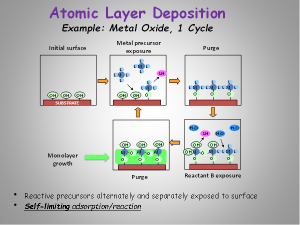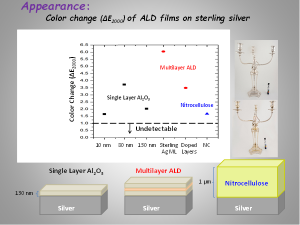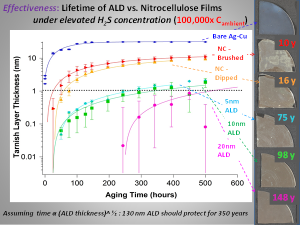Another somewhat unconventional research activity in my group is developing technologies for the conservation of Cultural Heritage (CH) objects, which provide us with links to past and future generations. These objects unfortunately degrade with time due to a number of effects including: corrosion, weathering, interaction with water, and interaction with light. Their conservation poses special challenges as the requirements for acceptance of a new technology by the Cultural Heritage conservation community include: that it outperform existing approaches in effectiveness, that it should not noticeably change the appearance of the treated object, and that it should be reversible. The approach that we have taken is based upon atomic layer deposition (ALD) of ultra-conformal, amorphous, transparent metal-oxide films. Our initial studies were carried out in collaboration with the Walters Art Museum in Baltimore, and focused on slowing the rate at which silver alloy objects tarnish due to exposure to atmospheric hydrogen sulfide. We found that coating sterling silver objects with ALD aluminum oxide meets the requirements for Cultural Heritage conservation: accelerated aging experiments showed such films to retard tarnishing up to 35 times longer than conventional lacquer-based coatings; films of certain thicknesses are essentially invisible to the observer; these films can be removed with a mild alkaline solution, with no change in appearance, and negligible compositional changes. In subsequent work carried out in collaboration with the Smithsonian Institution’s Museum Conservation Institute we investigated the potential of this approach in conserving the characteristic green and brown patinas that are found on antique bronzes-there are numerous variations in the composition of these, and our results showed that many of these can be successfully conserved via coating with ALD alumina. Presently we’re investigating the extension of this approach to a wide range of more challenging Cultural Heritage object, including some which are chemically heterogeneous and/or physically rough or porous.
Use of atomic layer deposition (ALD) to produce tarnish barrier films for silver art objects. (Left) Schematic of ALD process. (Middle) Comparison of color change of silver with ALD Al2O3 films of different thickness vs. that for conventional nitrocellulose lacquer films. (Right) Comparison of times for which nitrocellulose films and ALD Al2O3 films protect silver from tarnishing under accelerated conditions (main panel) and expected lifetimes under ambient conditions (right column).



